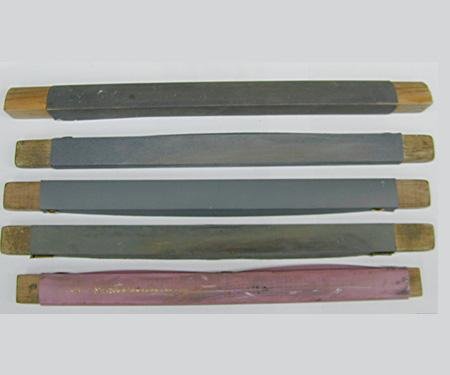Online Jewelry Training Classes for Metalsmiths



Making your own buff sticks also called emery sticks from a soft fine grained wood is easy and you can make profiles as needed. Personally, I use 280 and 1200 the most so I have two buff stick each of those. I also have a round, (not shown) ans a big quarter round which is not used often, but when it is needed it is perfect. The 2500 and 2 micron is used when I have solder joints that are in danger of being polished out. So then, if the piece is finished to a very fine grit, there is not much polishing left. Also, you cannot go from 600 to 2 micron. You have to first use the 2500 grit.
Making a buff stick allows you to make them in any shape and grit you want. The best average size is about 300mm by 22mm by 11mm. ( 12 inches by 7/8th inch by 3/8th inch ) This size uses a standard sheet of sandpaper, which is about 228 by 279mm ( 11 inches by 9 inches) with out any wastage. I use Maranti wood because it is not to hard and has a fine grain. It is used for window frames and floor skirting so it is common and cheap.
I use a scriber to score the sheet of sandpaper from behind to give me a nice crisp corner. This takes a bit of practice, because if you press to hard, you will cut the sandpaper, and if you press to soft, it will not be a sharp corner.
This is the kind of scoring that is correct.
Make buff sticks scoring other side.
And so the buff stick get rolled up.
The scoring makes for nice crisp corners.
Crisp edges on emery sticks are important for neat flat sanding and getting right into the corners
This size buff stick leaves a small strip to be cut off. I do this by scoring it a couple of time with my scriber until I score through the sandpaper.
One can use two drawing pins on either side of the buff sticks to hold the sandpaper in place.
Or some masking tape. Either work well.
But I prefer drawing pins, because it is neater to tear off the top layer when it is finished.
And that is of course the whole reason of rolling up the sandpaper, so the top strip can be torn off, exposing the new layer of sandpaper.
or select other projects from Jewelry Making Tutorials List
If you have any questions or wish to be notified of any new tutorials that are posted, email me.
This content is the intellectual property of Hans Meevis. More information on our Copyright and Privacy Policy